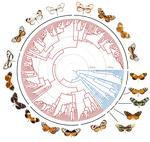
REE Richard H
- Botany Department, The Field Museum, Chicago, United States of America
- Bioinformatics & Computational Biology, Evolutionary Ecology, Macroevolution, Phylogenetics / Phylogenomics, Phylogeography & Biogeography, Systematics / Taxonomy
- recommender
Recommendation: 1
Reviews: 0
Recommendation: 1

Renewed diversification following Miocene landscape turnover in a Neotropical butterfly radiation
The influence of environmental change over geological time on the tempo and mode of biological diversification, revealed by Neotropical butterflies
Recommended by Richard H Ree based on reviews by Delano Lewis and 1 anonymous reviewerThe influence of environmental change over geological time on the tempo and mode of biological diversification is a hot topic in biogeography. Of central interest are questions about where, when, and how fast lineages proliferated, suffered extinction, and migrated in response to tectonic events, the waxing and waning of dominant biomes, etc. In this context, the dynamic conditions of the Miocene have received much attention, from studies of many clades and biogeographic regions. Here, Chazot et al. [1] present an exemplary analysis of butterflies (tribe Ithomiini) in the Neotropics, examining their diversification across the Andes and Amazon. They infer sharp contrasts between these regions in the late Miocene: accelerated diversification during orogeny of the Andes, and greater extinction in the Amazon associated during the Pebas system, with interchange and local diversification increasing following the Pebas during the Pliocene. Two features of this study stand out. First is the impressive taxon sampling (340 out of 393 extant species). Second is the use of ancestral range reconstructions to compute per-lineage rates of colonization between regions, and rates of speciation within regions, through time. The latter allows for relatively fine-grained comparisons across the 2 fundamental dimensions of historical biogeography, space and time, and is key to the main results. The method resonated with me because I performed a similar analysis in a study showing evidence for uplift-driven diversification in the Hengduan Mountains of China [2]. This analysis is complemented by a variety of other comparative methods for inferring variable diversification across clades, through time, and in response to external factors. Overall, it represents a very nice contribution to our understanding of the effects of Miocene/Pliocene environmental change on the evolution of Neotropical biodiversity. **References** [1] Chazot N, Willmott KR, Lamas G, Freitas AVL, Piron-Prunier F, Arias CF, Mallet J, De-Silva DL and Elias M. 2017. Renewed diversification following Miocene landscape turnover in a Neotropical butterfly radiation. BioRxiv 148189, ver 4 of 19th December 2017. doi: [10.1101/148189](https://doi.org/10.1101/148189) [2] Xing Y, and Ree RH. 2017. Uplift-driven diversification in the Hengduan Mountains, a temperate biodiversity hotspot. Proceedings of the National Academy of Sciences of the United States of America, 114: E3444-E3451. doi: [10.1073/pnas.1616063114](https://doi.org/10.1073/pnas.1616063114)